Return to Ode to My Father Film Guide
This section provides historical context that is key to understanding South Korea’s political and economic history. I suggest that teachers become familiar with this material and use it as necessary to supplement teaching and class discussion of the film. Key terms appear in bold face.
The Korean War & the Postwar Period
The Korean War has a devastating effect on the economy of the Korean peninsula. Both North and South suffered almost complete invasion and a subsequent counteroffensive that destroyed infrastructure and property (retreating armies often bombed their own supply routes to stymie invading forces). An initial onslaught by North Korea began in June of 1950 quickly overtook most of the South. The UN allied forces, led by the United States, pushed back and were advancing on North Korea’s northern border in China by October. In response, the People’s Republic of China joined the North Korean war effort and launched a counterstrike. Having just fought their own civil war, the Chinese army was seasoned, though also poorly supplied to fight in the bitter cold. In November, Chinese attached the US X Corps at the Battle of Chosin Reservoir, and forced US forced to retreat from the North. The Chinese pincer cut off escape routes by land, and the US military was forced to execute a huge retreat by sea at North Korean Hungnam port.
Fig. 1 (left) and 2 (bottom): The Hungnam Evacuation, December 1950. On the left, fuel drums awaiting evacuation on December 14th. On the bottom, refugees board a US transport on December 19th. Source: “Hungnam Evacuation, December 1950.” 80-G-423913 (left) and 80-G-424096 (right). 80-G0 Series. Naval History and Heritage Command Photo Archive.

Duk-soo’s life story in Ode to My Father begins during the Hungnam Evacuation as the family manages to board the SS Meredith Victory and flee to the South with
14,000 others. This redeployment operation drew analogies to the famous Dunkirk evacuation of WWII, though it was much more successful and well-organized. The Seventh Fleet, the American naval fleet stationed out of Japan, supported the X Corps as they evacuated 105,000 troops, 91,000 civilians, 17,500 vehicles, and 350,000 tons of supplies from Hungnam (Chisholm 54). Remaining materiel, meaning military supplies and weapons, were blown up to prevent them from falling into enemy hands. A newsreel produced for British Pathé, embedded below, shows the scope of damage executed upon the city by retreating forces. Anything that could have been useful to the enemy (North Korea and China), including factories but also an “oil and alcohol store” and North Korean administrative records, were destroyed. Only civilian homes, the narrator informs, were spared.
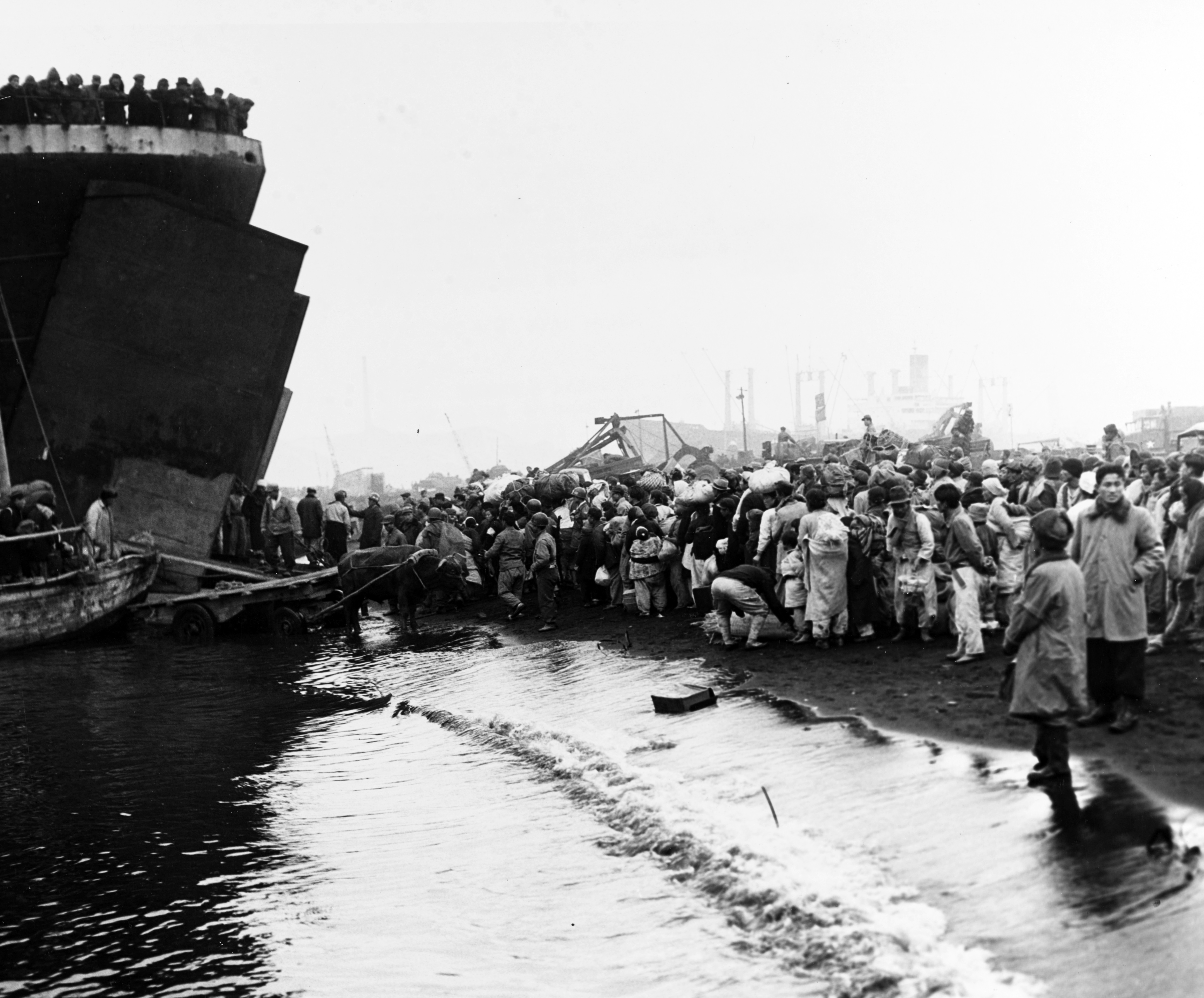
Ode to My Father leans into this sense of emergency as fleeing characters repeatedly voice worries over the Chinese advance. The evacuation has been mythologized in South Korean and American war lore. Admiral J. Robert Lunney, then a staff officer on the SS Meredith Victory, characterized the refugees as heroes who were “seeking freedom” (Korea Society). Nationalist discourse in South Korea likewise presents the Hungnam refugees as people seeking a “free state” (Kim 156). Critics of this interpretation point out that for war refugees, war destruction was a stronger motivator than ideology. After all, the allied forces themselves had effectively destroyed the city’s economic infrastructure, meaning that there was very little to stay behind for.
In the context of the Cold War, a “free state” and “freedom” were not neutral facts, but rather watchwords employed by American and South Korean propaganda. Both sides of the conflict perpetrated atrocities, including killing civilians who were fleeing military action. South Korea was an anti-communistauthoritarian state that hypocritically vilified the North while suppressing the political rights (see A Taxi Driver film guide) and exploiting the labor of its own people (see next section). South Korean state violence in no way absolves the repression faced by North Koreans, but it is important to understand that Cold War ideology presented South Korea as a “freedom’s frontier” even as South Koreans struggled to win democratic rights into the late 1980s. While Ode to My Father is thus contextually linked to the anti-communist narrative of South Korean history, it largely elides explicit politics. The term “commie” is used only once in the film’s 1950s section. Duk-soo is accused of being a communist by a classmate who learns that his family comes from North Korea. He adamantly denies the charge and the scene is played for laughs and the two boys become bests friends. The exchange is significant, however, because even as the young children do not really understand what communism is, their banter implies that they are very aware of the nation’s political division and the serious risk of being identified as a “commie” in anti-communist South Korea where such a charge could lead to imprisonment and even death.
Fig. 3: “You a commie?” Screenshot from the film.
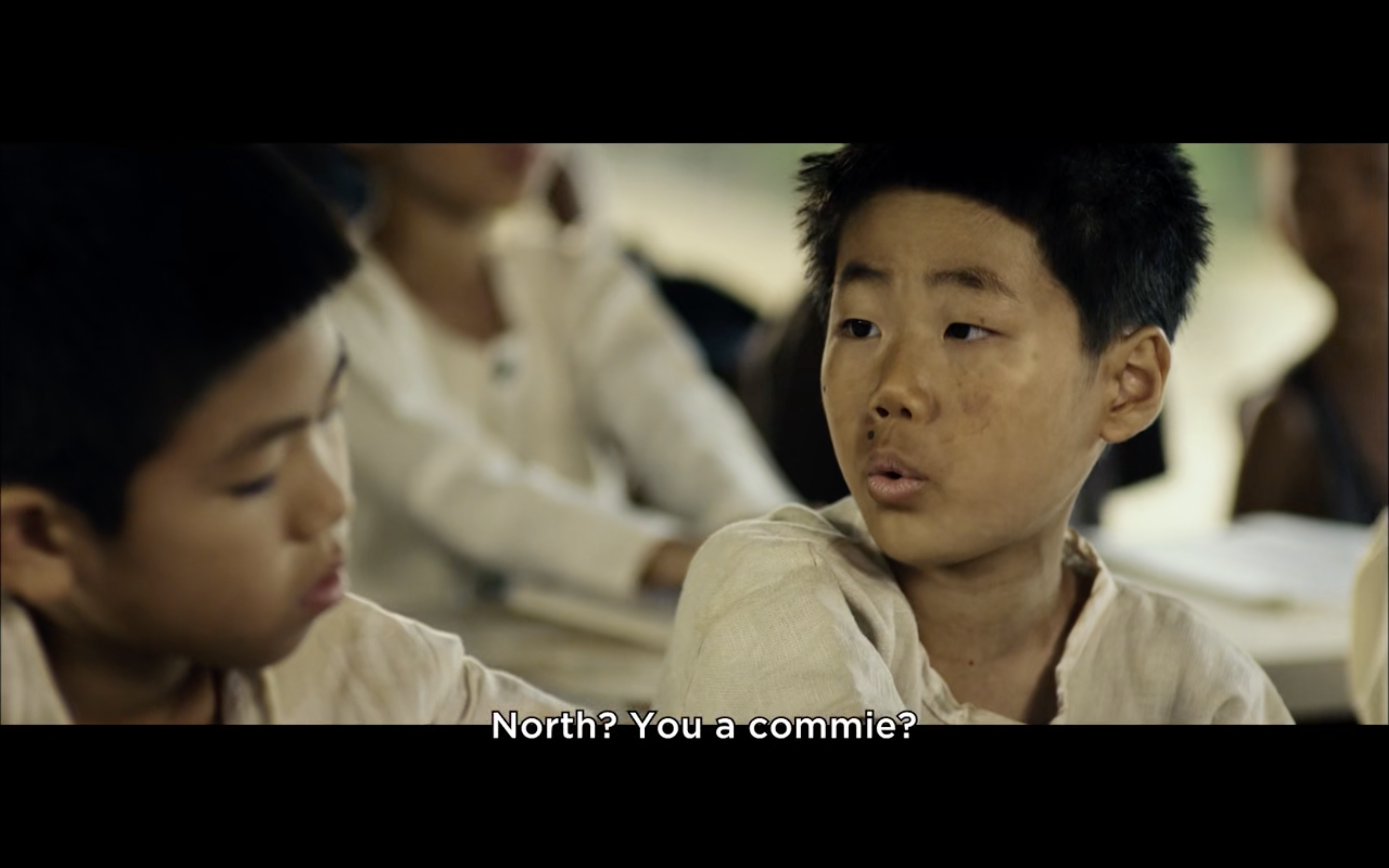
Duk-soo learns this political lesson while living in Busan, the southern port city in which Ode to My Father is largely set. Busan was a major refugee center that receiving hundreds of thousands of displaced Koreans from the North and South. Many from the North ended up settling in the city after the Korean Armistice Agreement ended hostilities on July 27, 1953. The Provisional Capital Memorial Hall, a museum in Busan, curated a digital exhibit of photographs that shows the conditions of life in wartime and early postwar Busan. Busan was also the provisional capital of South Korea while Seoul was under North Korean control. South Korea’s first president, the authoritarian anti-communist Syngham Rhee, ruled from the southern city. Busan was also a wartime center of arts, culture, and education in South Korea. The enormous influx of people stressed the city’s housing infrastructure, and shantytowns grew up near the city’s markets, including Gugkje Market, where Duk-soo’s family lives. The film focuses on primarily on this locale, a densely packed district overflowing with impoverished refugees as well as hopeful entrepreneurs and American soldiers.
The economic opportunities afforded by the American presence in South Korea were many, though not all were equally safe or profitable. Duk-soo’s aunt Kkotbun legally runs an import store with American goods that flowed into the city to supply US military operations. Such goods were in high demand and spurred the creation of a black-market economy. The famous 1958 film The Flower in Hell (dir. Shin Sang-Ok) explores illegal smuggling and touches on another significant war and postwar industry: prostitution. In a dark echo of the wartime Japanese practice of comfort women, or sexual slavery, the South Korean state facilitated large scale prostitution that serviced the American military, largely in so-called camp towns, villages that grew up around American military installations to serve their needs. In 2022, a group of women won a case against the South Korean state in court and earned compensation for the sexual trauma they endured as sex workers. A New York Times article on the case quotes 1961 documents from the Gyeongi Province government that sees it as “urgent to prepare mass facilities for comfort women to provide comfort to U.N. troops or boost their morale” (Choe). In addition to providing “comfort,” South Korean sex workers also injected the struggling South Korean economy with much needed foreign currency. The government, though disdainful of sex work in general, considered sex workers “frontline warriors” whose technically illegal labor contributed to postwar economic development (Choe).
Although prostitution catering to the military was (and to this day, is) present in Busan, the film does not touch on this practice. Instead, it focuses on a more “wholesome” imbrication of economy and military. In one 1950s scene, Duk-soo is shown working as a shoe-shine boy on the street. He polishes the shoes of a young man dressed in a Western suit. Meanwhile, Dal-gu, his friend, berates a group of children that just ran past them in chase of an American Army jeep in hopes of receiving a Hershey’s chocolate bar as “beggars” who are keeping “our country” poor. The snappily dressed businessman strikes up a conversation with the boys, asking Duk-soo what he'd like to be when he grows up. A naval captain, the boy replies. The stranger announces that he hopes to build “big ships,” which Dal-gu scoffs at, since he doesn’t believe it’s possible for Korea to manufacture such vessels. The businessman argues that it’s enough to show investors where he will build shipyards, and the future will come to pass. He hops onto a passing car, and the camera shows the name businessman’s company. This was Chung Ju-yong, the founder of Hyundai, now a powerful and internationally known conglomerate, or chaebol, and one of many corporations whose contracts with the American military served as a backbone for South Korean economic development in the postwar period.
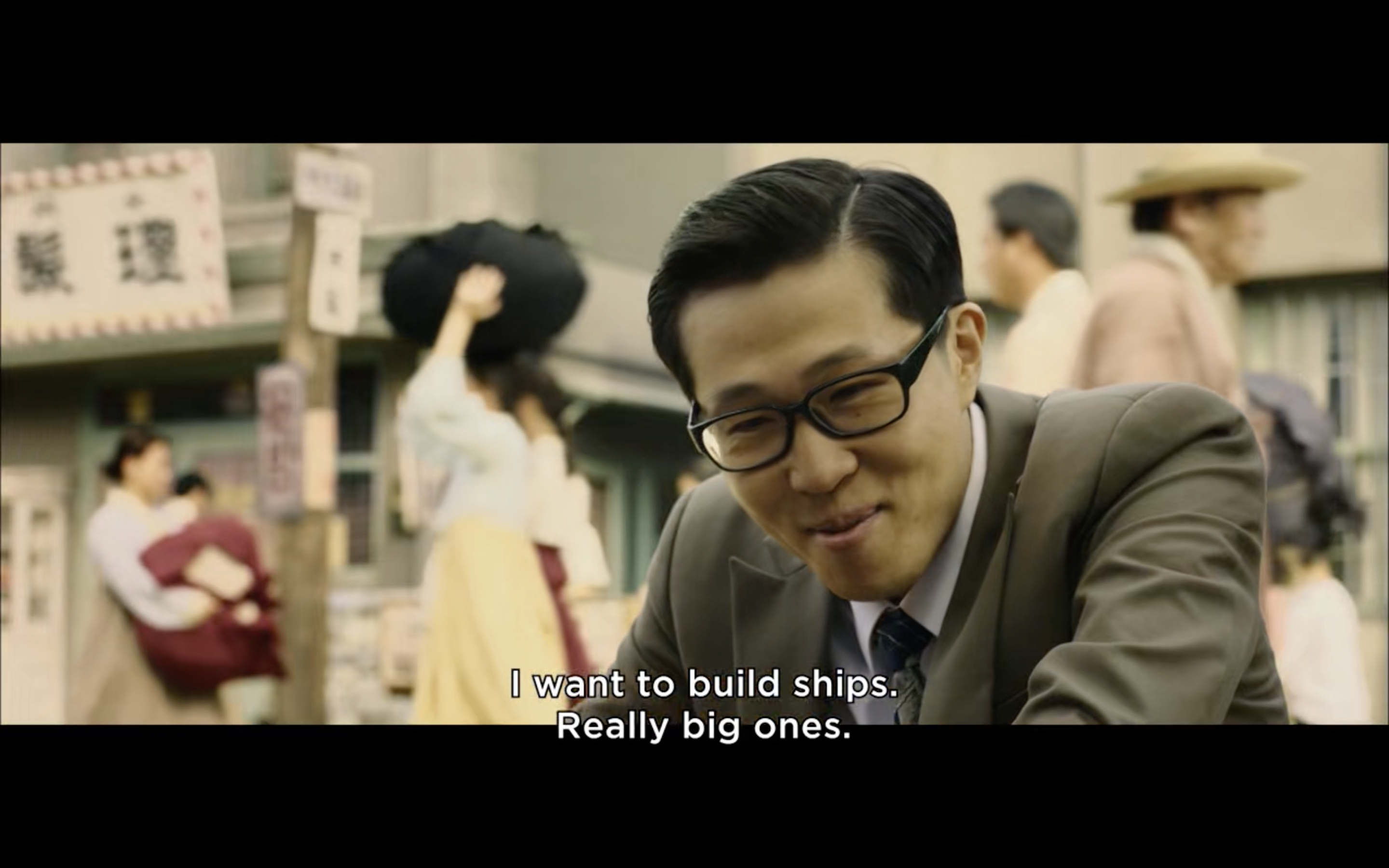
Fig. 4: Duk-soo dreams of being a ship captain in vain, while Chung Ju-yong muses about the future that will come to pass for him and his company, Hyundai. Screenshot from the film.
Labor Commodities
The founder of Hyundai is presented in the film as a dreamer, but South Korean industrial leaders were quite ruthless bosses who exploited labor to offer desirable contracts to the US military. The close relationship between South Korean labor and the US military began in the Korean War. The conflict was logistically difficult because of the peninsula’s hilly terrain, and the allies relied on Korean workers throughout the war to help move supplies and munitions, first building infrastructure and then moving goods across it. US military historian Patrick Chung has shown that Korean laborers were crucial to the war effort because they took over duties from American soldiers and lowered costs (since they were paid significantly less than Americans). As a result, Korean labor eased domestic pressures to bring troops home and allowed the military to cut expenditures. While the US military paid its “foreign” labor force little, it was the Korean bosses pushed workers the hardest, “and enforced work hours that would have been illegal in the United State” (Chung 36). Chung continues:
For example, the Hyundai Corporation became a preferred US military contractor during the war in large part due to its exploitation of workers. Drawing from the abundant supply of displaced and desperate individuals, Hyundai founder Chung Ju Yung regularly pushed his workers to perform backbreaking construction and transportation work for up to fifteen hours per day (36).
The amiable businessman Duk-soo met, in other words, built a successful company by contracting with the US military and exploiting the labor of individuals like Duk-soo, “displaced and desperate individuals” who took whatever work they could to support their families during the war and its aftermath. Mass displacement and war destruction had severely disorganized the economy, but there was economic opportunity for companies like Hyundai in this chaos.
During the postwar period, economic development was tied to the United States. For one, the US retained a troop presence in South Korea that relied on local labor. The US also directly supported the South Korea economy through generous foreign aid programs that historians credit with saving the South Korean state from collapse. Despite being leveled by US bombings in the Korean War, the North was recovering more quickly and maintained a stronger economy than South Korea through the 1970s. This communist success was a problem for the anti-communist state, since its legitimacy relied on the corresponding illegitimacy of communism. Developing the economy quickly was a Cold War political imperative and American foreign policy goal. In this context, aid was not a transparently humanitarian effort meant to lift ordinary Koreans out of poverty. It was a political tool that various powerful actors could manipulate to their advantage. Sociologist John Lie explains:
It was U.S. aid that facilitated a parasitic relationship between state bureaucrats and dependent capitalists. The president and his coterie emerged as the nexus between the bountiful United States and those South Korean capitalists who were to rap monopoly profits from processing and distributing U.S. aid materials (26).
The cozy relationship between the government and business did not lead to dramatic economic development for the average South Korean. While Syngman Rhee’s government muddled through the 1950s, South Korean cities grew, and an urban middle class began consuming foreign goods and cultural products. Lie explains that the consequent “desire for modernity and material goods stimulate[d] the urge for economic growth” (42). South Koreans were dissatisfied with both economics and politics, and a 1960 student protest movement brought down the Rhee government. Despite a brief hope for democracy, however, another dictator, Park Chung Hee, took power in a 1961 coup.
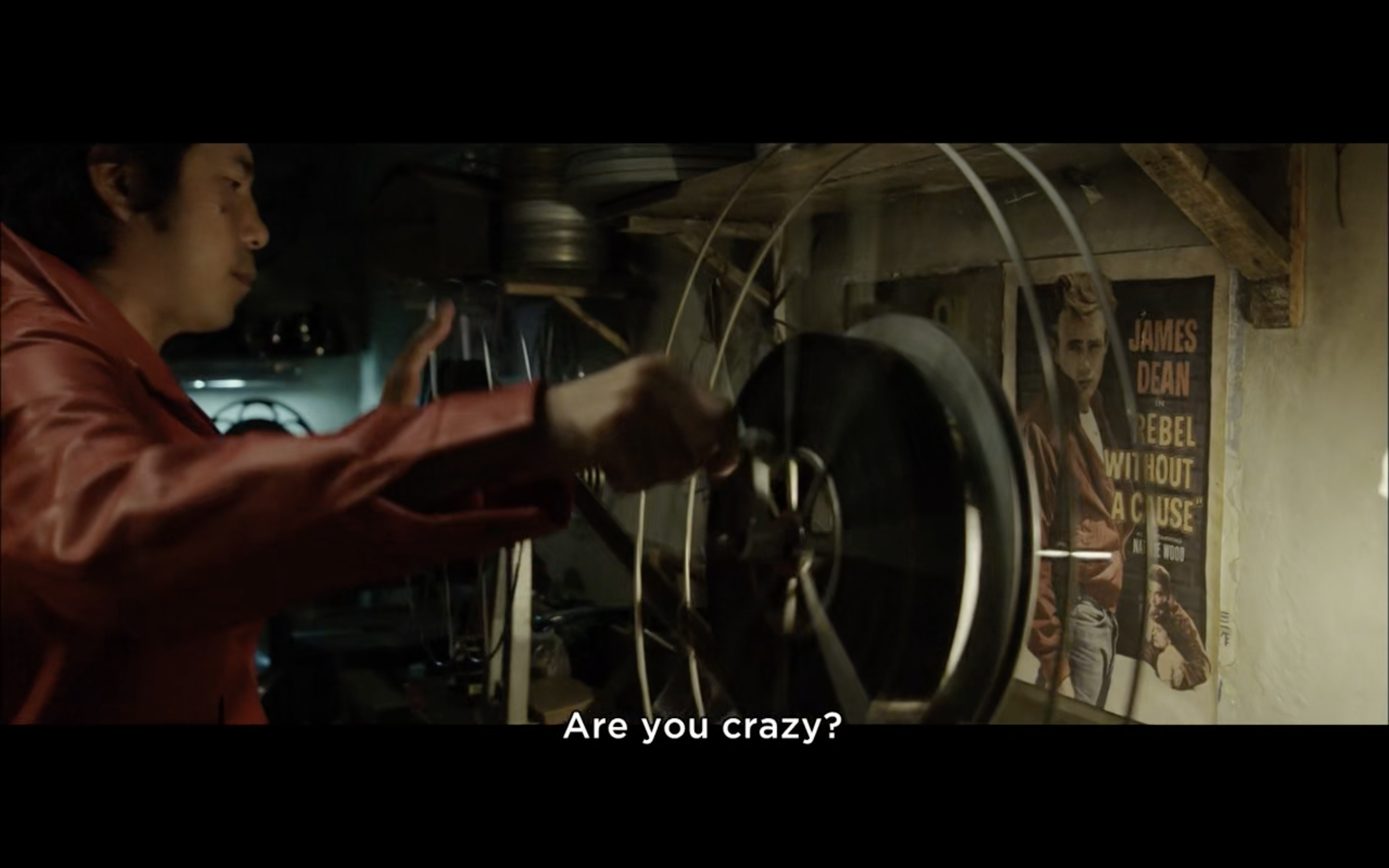
Fig. 5: Dal-gu, who works at a movie theater, has adopted the dress and hairstyle of James Dean, identifying with the rebellious spirit of the stylish American actor.
Park’s tenure as president (which ended with his assassination in 1979) is associated with South Korea’s rapid economic growth. It is also a period that is nostalgically remembered as a time of opportunity by many in South Korea. The nostalgic tint of the Park era was especially strong in 2014, when the film was made, because Park’s daughter was elected (democratically) as president in 2012. While Park senior’s reign saw dramatic improvements in the South Korean quality of life, it was hardly a rosy period. Economic growth relied on workers who were increasingly unhappy with their poor treatment. Labor unrest led to often violent political suppression. Intellectuals critical of the government also joined ranks with workers, combining calls for fair employment practices with a desire for democracy and freedom of speech. Again, Ode mostly omits mention of political as such, but the effects of Park’s political programs are keenly felt in the circumstances experienced by the film’s characters
In the late 1950s and early 1960s, unemployment remained relatively high, reaching 30% in the early 60s (Roberts 197). Changes in American aid programs threatened to upend South Korea’s economic recovery. The United States Agency for International Development (USAID) was established in 1961, and its mandate to expand programs to various developing countries in Africa and Latin and South America meant financial assistance to South Korea would be curtailed. South Korean still needed large influxes of foreign currency to keep growing its economy. The government looked to other Cold War allies beyond to help resolve its developmental needs. A US Foreign Aid Agency program that sent Japanese miners to work in West Germany in 1957 caught the government’s attention, and soon, West German bureaucrats were invited to South Korea to work out a similar deal (Jeon 307). In 1963, the two governments reached a bilateral agreement to supply voluntary and temporary labor that would bolster the European country’s own economic growth. West Germany had reaped the benefits of postwar aid and recovered rapidly from the devastation of World War II. The success of the “Miracle on the Rhine,” as the country’s postwar recovery has come to be known, was impaired however, by labor shortages. South Korean “guest workers,” in German Gastarbeiter, could step in to cover such shortages in the healthcare and mining sectors. Workers from other nations also participated in this migration scheme, and South Koreans were also temporary workers in other nations. Saudi Arabia, for example, employed 70% of the hundreds of thousands of South Koreans who worked in the Middle East in the 70s and 80s. South Korean construction companies, leveraging their experience as contractors to the US military, especially during the Vietnam War, were active participants in the Middle Eastern development enterprise. As in their US contracts, the firms were able to offer financially attractive deals because their labor costs were low.
The first group of miners was dispatched to West Germany in 1963 for a three-year contract. A second program was initiated in 1977. In total, 8,000 South Koreans worked in West German mines under these agreements in the 60s and 70s. The men worked for three-years and where then expected to return to South Korea and be replaced with new recruits. Nurses had been travelling to work in West Germany since the late 1950s, but these early groups were organized privately. In the mid 1960s, the South Korean government became actively involved in the dispatch of nurses, changing the stakes of the original labor exchange (Yu & Seo 227). In total, about 11,000 South Korean nurses were dispatched. Initially, the arrival of the nurses in West Germany was understood in terms of education. When the women returned to South Korea, they could help develop the nation’s healthcare infrastructure with the knowledge they had gained in the West. The program was billed as a developmental initiative with direct benefits for South Korean citizens who would enjoy more modern healthcare. In the film, Youngja is shown in a lecture hall. This positive note, however, is deflated when her nose starts bleeding onto her notebook, betraying the tremendous physical cost of her labor.
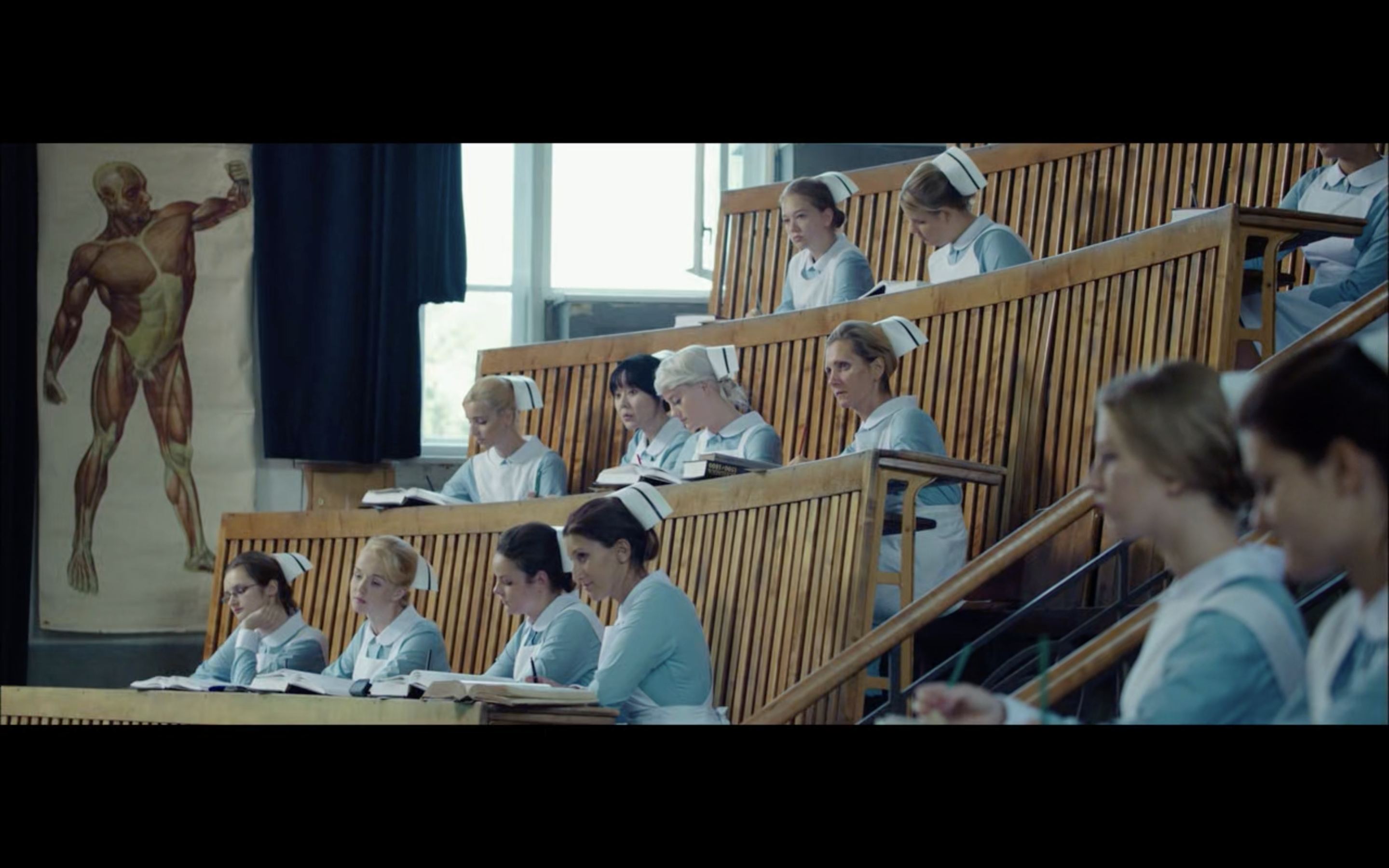

Fig. 6 & 7: Youngja is so exhausted from her difficult shifts that her nose starts bleeding onto her notes during a lecture. During this montage of Youngja’s work life, which is set to a voiceover of the Youngja’s conversation with Duk-soo, he comforts the young nurse by suggesting the two “cry together.” There is no notion of protesting these labor conditions. Screenshots from film.
The government’s more active role nurse exchanges changed the stakes of the initial program: “The focus of the agreement gradually shifted from providing educational assistance to engaging in labor trade” (Yu & Seo 227). The West German press and various organizations in the country criticized the exploitative terms of the agreement, especially questionable given that South Korea experienced labor shortages in the nursing sector during this time. Some critics, including those in North Korea and China, resorted to language that equated the migrant labor with slavery. This was a potent accusation during the height of the Cold War, since it painted the “free” South Korea in a negative light at a moment when North Koreans enjoyed comparatively good standards of living. The inflammatory characterization of slave labor is worth taking apart to understand exactly how labor was instrumentalized by the state. The nurses and miners were paid much more than they could have earned back home. They were, however, expected to withstand poor working and living conditions. A miner recalls: “I would work 7 hours a day on a three-part rotational shift, 1,000-meters underground. The temperature was above 40 degrees Celsius, everything was pitch black and deadly quiet. Debris constantly fell from the ground tunnel’s ceiling” (“Korean miners, nurses recall their arduous days in Germany”).

Fig. 8 & 9: (left) A South Korean miner working in West Germany. (bottom) A group of South Korean nurses in front of a West German hospital. Source: These uncredited photos are featured in a story about South Korean migrant labor published by The Korea Herald. “Korean miners, nurses recall arduous days in West Germany.” The Korea Herald, October 9, 2017. https://www.koreaherald.com/article/1466435.
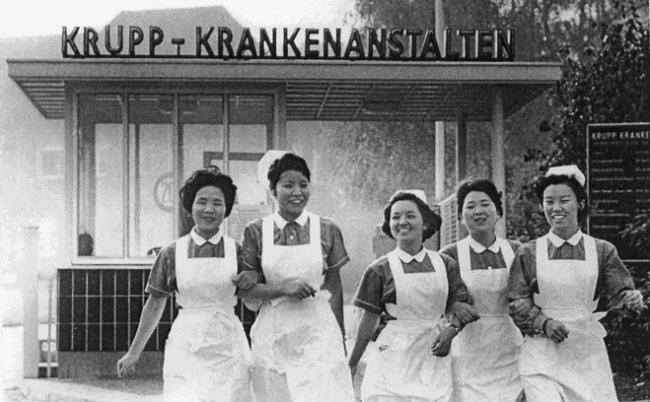
The short contracts under which South Korean migrant laborers worked foreclosed their access to legal labor protections enjoyed by West German workers. A three-year contract was designed to prohibit social integration. The South Korean workers were temporary migrant workers who were supposed to return to South Korea, not immigrants who would settle in West Germany permanently (though some fought and won the right to stay). Scholars have described the scheme as an exchange of “labor commodities.” Young -sun Hong notes, “In the eyes of the Korean officials and recruitment intermediaries, these women were commodities that could be exported like any other. What remained invisible were power relations in Germany and Korea that determined how and why these women entered the global labor market” (262-263). This labor commodity exchange was packaged in patriotic language. The miners and nurses were construed as patriots who helped South Korea develop. The South Korean government needed foreign currency and was willing to trade South Korean labor to initiate its flow. Nurses and miners were paid directly, but it was expected that they would send most of their income home as remittances. They did, and their remittances pumped about 50 million dollars into the South Korean economy yearly, a significant portion of the nation’s GDP (Roberts 197).
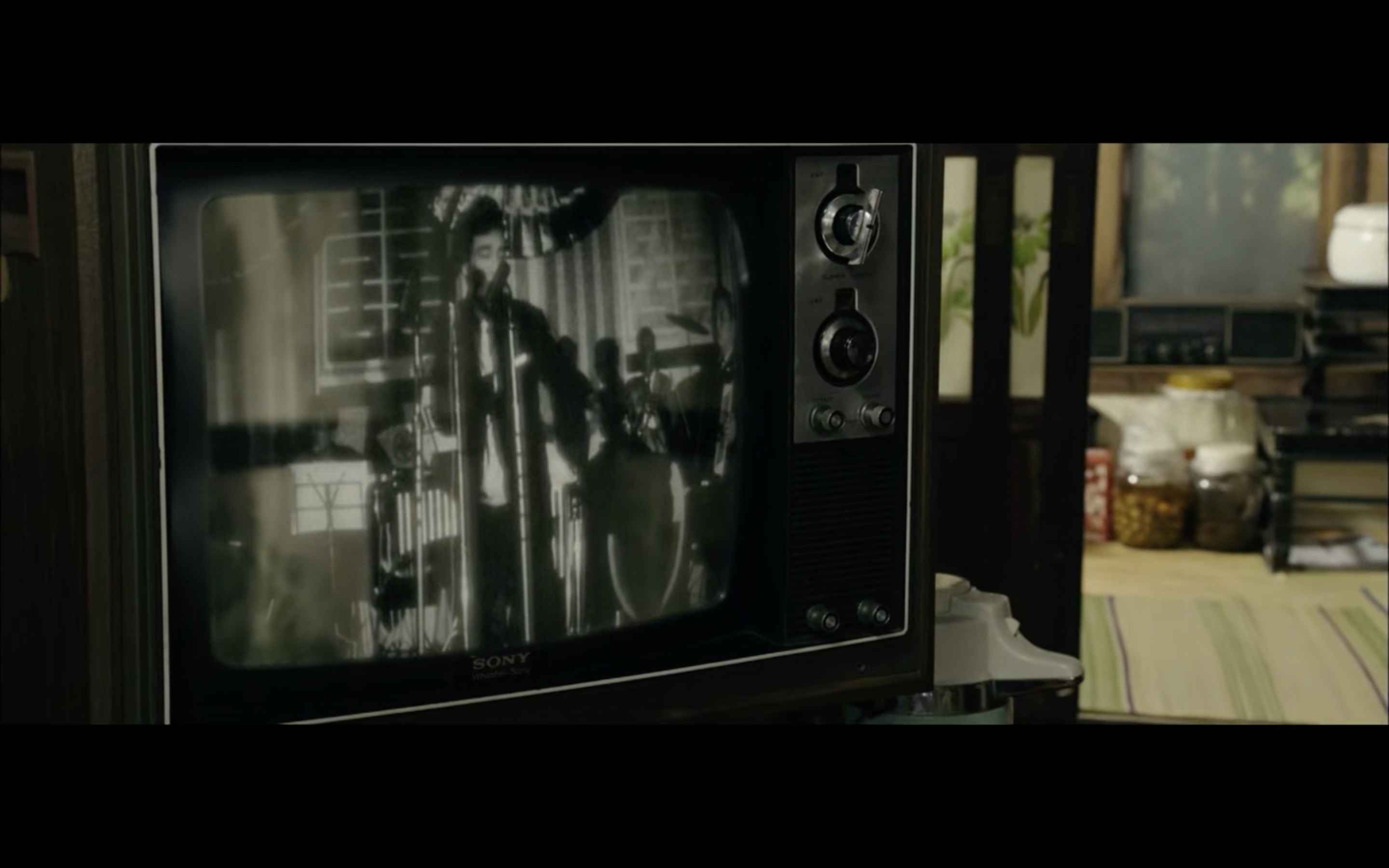
Fig. 10: Duk-soo’s family home now has a Sony television, its brand clearly visible in this shortcut. The presence of this TV underscores both Duk-soo’s remittances and the recent normalization of relations with Japan. Screenshot from film.
The flow of remittances is visible in the film when Duk-soo returns home after his stint in Germany. His family can afford a comfortable home and a Japanese television, an import made possible by the recent normalization of relations between with Japan that further integrated South Korea into the capitalist East Asian economy. As in its earlier sections about the war and postwar period, the film illustrates such historical complexity only implicitly. Viewers have to know the historical backdrop against which the film unfolds to fully understand how Duk-soo’s labor contributes to the South Korean nation building project. South Korea was able to experience a repeat of West Germany’s success, known as the “Miracle on the Han (River),” because of the tremendous effort of workers like Duk-soo.
Military Labor, Military Society
Cold War Asian economic development was closely tied to warfare. The massive mobilization necessary to fight the Korean War was a decisive element in Japan’s postwar recovery. The nation supported American troop deployment and assisted in the development of logistic necessary for the US to carry out the war. The Vietnam War played a similar role in South Korea’s economic growth. Park Chung Hee’s domestic policies, including ambitious “Five Year Plans,” were designed to aggressively develop the country’s economy, but it was the country’s close relationship with American foreign policy interests that allowed key sectors in the South Korean economy to really thrive in the 60s and 70s. Relationships between South Korean companies and the US military that had begun during the Korean War and continued in the postwar period provided the springboard for further economic growth. With the amplification of the Vietnam War after 1964, the United States military would once again rely on South Korean contractors to build transportation infrastructure and maintain supply logistics.
The US was involved in the civil war unfolding in Vietnam since the country regained independence and underwent division in the 1950s. America supported the anti-communist government in the South and sent military advisors to help the South Vietnamese control a communist insurgency, the Viet Cong, which was in turn supported by the North. In 1963, the South Vietnamese president was assassinated, and North Vietnam began actively supplying its own troops to support the Viet Cong. In 1964, the Gulf of Tonkin Incident, a minor skirmish between North Vietnamese forces and US navy, became the pretext for increased American involvement in the conflict, first with significant bombing, and by 1965, with growing numbers of ground troops. As in South Korea, the United States was aligned with anti-communist South Vietnamese leaders whose repressive politics were an awkward fit with values like democracy and freedom touted by America during the Cold War. The domino theory, embraced by presidents Kennedy and then Johnson, posed that allowing for a communist government to take power in one country would lead others in the region to follow. This anti-communist Cold War calculus overshadowed other concerns and legitimized intervention.
Despite early ties to workers’ political organizations, Park Chung Hee was a strident anti-communist. Still on shaky ground after his 1961 coup, he needed to ingratiate himself with the United States to maintain a hold on power. US foreign aid, including expenditures that supported the South Korean army, was declining and conditional (on the right political stance). Park was proactive in aligning his new government with US foreign policy interests to stabilize politics and economics as he came into power. Unlike Rhee, who remained hostile to Japan while he was president, Park presided over a normalization of relations with the former colonial power that was finalized in 1965. This decision not only brought South Korea closer to US interests in the region, but also gave South Korean businesses and consumers access to the booming economy of its neighbor. The decision to join the fray in Vietnam, writes Min Yong Lee, was motivated by similar political and economic interests. By presenting a strongly anti-communist stance, Park hoped to convince American policymakers that South Korea was an integral partner in the battle against global communism. The political and economic rally was especially necessary to legitimize Park’s rule, because North Korea was flourishing, both domestically and internationally.
Park first approached the US with an offer of military assistance in 1961, offering South Korean troops as a quid pro quo for continued military support of the South Korean army. The US was not yet committed to the Vietnam War on a significant scale in 1961, but by the middle of the decade, the stakes of the war had changed, and his offer was welcome. South Korea initially pledged 20,000 military personnel in 1965, but it ended up sending over 300,000 troops to fight the war through 1973, when the last soldiers returned. In exchange for these troops’ service, the South Korean state received more than $9 billion of aid (Chung 40) and secured $2.7 billion in foreign loans (Lee 427). Soldiers, however, were not the only South Koreans who contributed their labor to the Vietnam War effort nor was direct aid the only economic benefit of the war.

Fig. 11: This photo appears in an NPR article about war crimes committed by South Korean troops in Vietnam. The caption reads: “South Korean troops bound for Vietnam march in Seoul in the 1960s. South Korea, then ruled by a military leader, sent some 320,000 troops to fight alongside the U.S. in Vietnam, the largest contingent of any U.S. ally. Archive Photos/Getty Images. Source: Kuhn, Anthony. “A Vietnam was massacre case from 1968 forces a new reckoning in South Korea.” NPR, April 12, 2023. https://www.npr.org/2023/04/12/1167951366/south-korea-vietnam-war-massacre-court-case
The Vietnam War proved to be a great economic “opportunity” for South Korean business. “Hanjin founder seized opportunities with a good sense of timing,” reads a headline in a 2012 Korea Times article about the shipping corporation’s early history in Vietnam. Given the context of a horrific war, this phrasing appears strikingly tone death, but it conforms to a nationalist historical narrative about South Korean development: corporations and their leaders are heroic patriotic actors that allowed South Korea’s economy to achieve an economic “miracle.” In addition to fees collected for services they rendered, South Korean companies gained access to new business networks and technologies that allowed for rapid growth. Cho Choong Hoon, the founder of Hanjin, for example, “glimpsed the future of the shipping industry in the spring of 1966” in Quy Nhon when he saw an intermodal shipping container (Chung 31). Containterization increased efficiency and cut costs, thus helping to control rising expenditures related to the Vietnam War. Working with other contractors that serviced US military logistics, South Korean firms could quickly adopt the innovation and thus become competitive in global shipping markets after the war.
Fig. 12: This image is featured in an article published by The Korea Times. The caption reads: “Hanjin workers unload supplies for U.S. military forces at Quy Nhon, Vietnam, in 1968. Hanjin Group founder Cho Choong-hoon signed a $7.9 million contract to unload military supplies. / Courtesy of Hanjin Group.” Source: “Hanjin founder seized opportunities with good sense of timing.” The Korea Times, December 2, 2012. https://www.koreatimes.co.kr/www/biz/2025/01/602_192261.html.
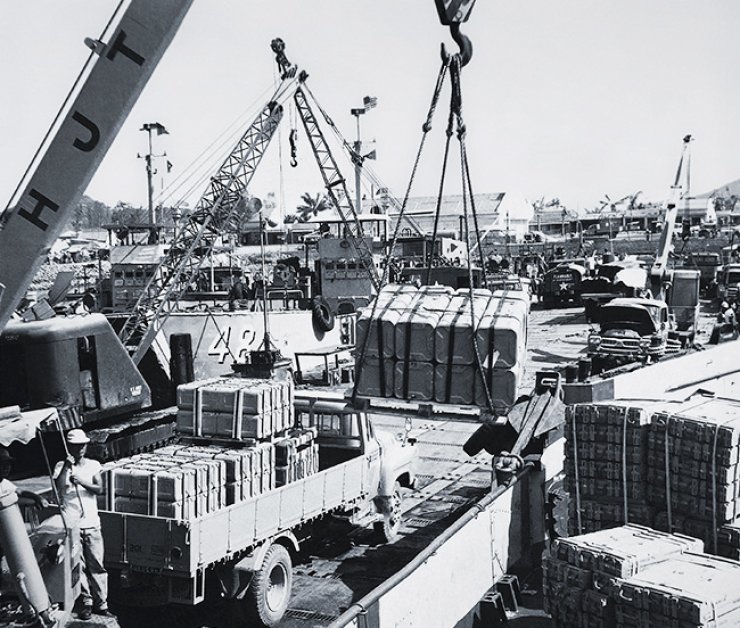
The violent circumstances under which such economic development was possible are either brushed aside or romanticized as patriotic sacrifices. Hanjin workers in Vietnam, for example, worked well over the 60 hours per week stipulated in their contracts, but received no overtime pay (Chung 43). Despite workers’ protests, the US military did not intervene in favor of labor rights. Businesses profited, while the average worker saw a relatively small portion of the economic returns generated by the war (their salaries, sent home as remittances, did have a significant impact on the growth of the South Korean economy). Tens of thousands of South Koreans worked for companies like Hanjin, Hyundai, Tonga, and Hyosong, as well as for military American private contractors in South Vietnam. They unloaded ships, paved airports and roads, and delivered supplies to the troops. Like South Korean soldiers, who cost one third to equip compared to American counterparts, South Korean workers came cheap (Chung 40). More cynically, South Korean workers:
…provided not only cost but also political benefits. At a time when every US casualty fueled the growing antiwar movement at home, the US military’s expanded use of more disposable non-US workers was a major asset for military leaders. In particular, Hanjin drivers took the place of US drivers in transporting supplies to the front lines. The constant threat of North Vietnamese ambushes caused much consternation for Hanjin drivers—one of the company’s drivers recalled that his job was no different from that of Korean soldiers (Chung 43).
The contributions of South Korean workers to the Vietnam war, both military and logistical, shows how strongly politics is tied to economics. Chung continues, “Hanjin workers helped US military officials achieve both economic and political objectives. Their low wages lowered the US defense budget. And every Korean casualty or death in place of an American one helped ease domestic backlash against the war” (Chung 43-44). In other words, South Korean labor displaced the financial and political costs of war by dying in place of American troops.
In Vietnam, South Korean labor was directly tied to military operations. Meanwhile, back home, South Korea became a militarized society in which citizens and workers were construed as warriors who fought for the betterment of the nation. Park, to the growing chagrin of the US, was a violent authoritarian. Cold War détente in the late 60s and early 70s meant that his strong anti-communist stance was no longer as attractive to American policymakers. US officials were already making overtures to communist China, after all, and Nixon visited the People’s Republic in 1972 to improve relations. In Park’s Korea, dissent, including doubts about the Vietnam War and rapprochement with communists, was forbidden. Political opponents to the regime, including labor activists, were repressed. The video embedded above gives a sense of how events such a return of troops were orchestrated as nationalist spectacles. Eerily, the ceremony at the train station looks very much like those staged in the colonial period when Korean volunteers went off to fight in World War II in the service of their Japanese colonial masters. The nationalism mandated of ordinary people in 60s and 70s South Korea is visible in the film. As Youngja and Duk-soo fight about his decision to go work in Vietnam in a park, the “Pledge of Allegiance to the Flag” begins playing over loudspeakers. Youngja is initially too exasperated to respond and remains sitting. Upon noticing that others in the part who have stood to recite the pledge are looking at her warily, she stands and completes the communal ritual. Park’s grip on South Korean society was broken by his assassination in 1979. By the next year, a new dictator, Chun Doo-hwan, took over. Despite the change in leadership, the 70s and 80s shared a political economy “in which the strong capitalist state took a consistently pro-capital and anti-labor stance to promote rapid economic growth” and a “militarized” corporate culture that that regularly sacrificed the health and safety of workers to attain strong economic growth (Koo 67).
Dispersed Families
The film’s last vignette takes place in the 1980s. The decade began, hopefully but ultimately tragically, with the brutal suppression of the Gwangju Uprising in 1980. The political upheavals of the late 70s and early 80s are absent from the film (as is the 1961 student movement). Instead, the decade is illustrated primarily through the lens of Finding Dispersed Families, a Korean Broadcasting System (KBS) television program that became a media event in the summer and fall of 1983. The program, write scholars Suk-ho Jun and Danile Dayan, was designed to commemorate the 30th anniversary of the Korean War by giving ordinary South Koreans a chance to reconnect with lost family members. The mass media had promoted similar programs before, including in a 1960s newspaper campaign to reunite families with war orphans and a 1970s family reunion radio program that together reunited about 700 families. After a middle-aged man moved producers and audiences by sobbing for his lost children in a shorter program that aired in June of 1983, producers at KBS decided to add a longer live family reunion program to their commemorative events.
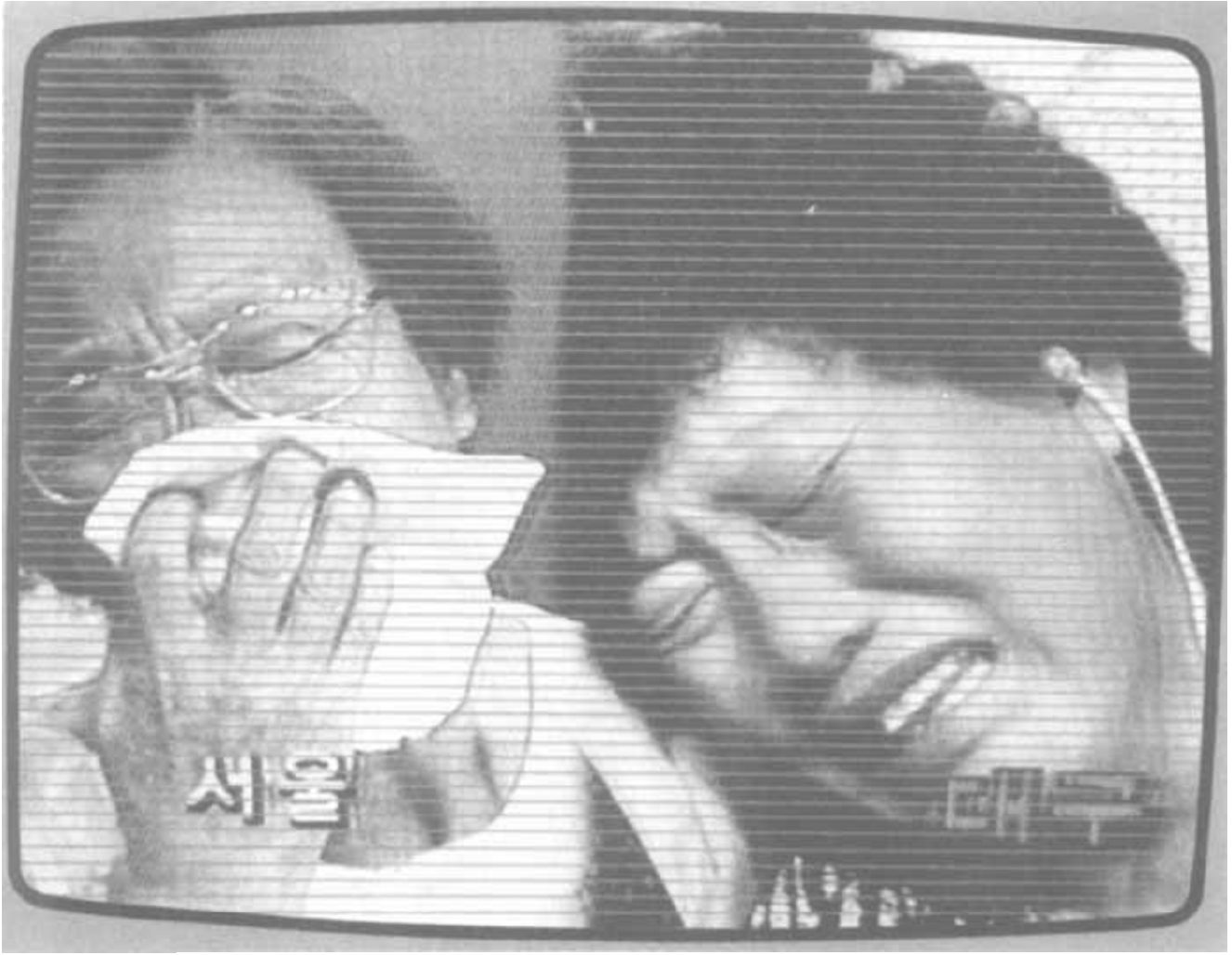
Fig. 13: (left) This screenshot of the original program appears in Jun and Dayan’s article, “An Interactive Media Event: South Korea’s Televised ‘Family Reunion.’” Journal of Communications 36, no. 2 (1986): 73-82. On the left, the screen reads “Seoul,” and on the right, “Daegu,” another city in South Korea. The same scene of family reunion appears on a television set in Ode to My Father.
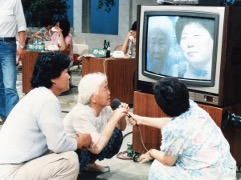
Fig. 14: (right) A photograph of the program held by the KBS Finding Dispersed Families photo archive. The woman in front of the television appears on the left of the split screen. The woman on the right is being recorded in an affiliate studio in Daegu. Source: Vol. 1, no. 10. Dispersed Families Photo Record. Korean Broadcasting System Archive. http://family.kbsarchive.com/cyber_gallery/kbs_photoalbum/
Since it was conceived of on the go, Finding Dispersed Families first aired on June 30th in a late night slot, 10 p.m. to midnight. The program garnered over a thousand applications. To accommodate such a high number of people, participants were asked to make signs that identified their lost family members that hosts could read out loud. Despite the late hour, many people tuned in and began calling the station after recognizing family members, and 36 reunions took place. What was originally an extra bit of programming became the main focus of the televisual events surrounding the 30th anniversary of the armistice. Jun and Dayan write, “The unexpected and explosive response prompted KBS to extend the program until 2:30 a.m. and to resume the special live broadcast at the same time the following night” (76). The scope of the program grew, first beyond Seoul to other cities, then internationally to Frankfurt, West Germany and the United States, where ABC Los Angeles telecast the program. Finding Dispersed Families went on to air live weekly until mid-November and resulted in the reunification of 10,189 families during its 450+ hours of airtime.
South Koreans participated actively in the program. In addition to appearing on weekly broadcasts, people looking for lost family members gathered outside the Korea Broadcasting System headquarters in Yeouido, a large island on the Han River in Seoul. There, they posted and read signs with identifying information like those that were featured in the television program.
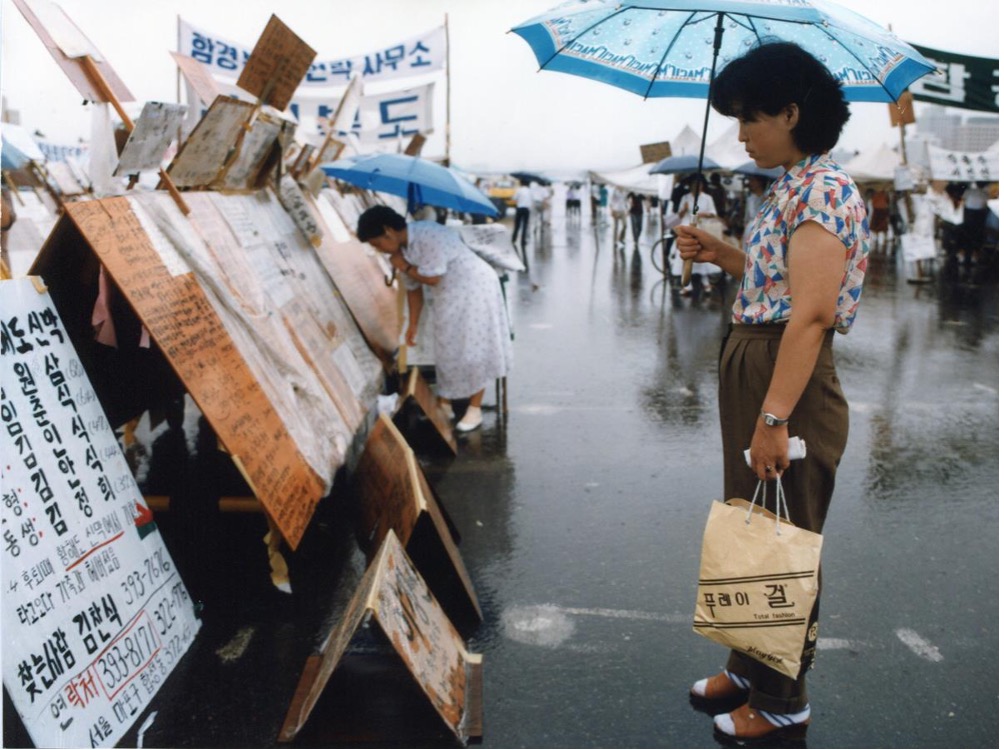
Fig. 15: (left) A woman reads information about missing family members in Yeouido. Source: Vol. 6, no. 4. Dispersed Families Photo Record. Korean Broadcasting System Archive. http://family.kbsarchive.com/cyber_gallery/kbs_photoalbum/
Fig. 16: (below) People watch the program as it airs on a television set up outdoors. Source: Vol. 3, no. 32. Dispersed Families Photo Record. Korean Broadcasting System Archive. http://family.kbsarchive.com/cyber_gallery/kbs_photoalbum/

Between those assembled on the plaza and the participants who participated in the program (over 100,000 applied and 50,000 appeared on air) the media event mobilized South Korean society. In a nation where television content often felt contrived for propaganda purposes, Jun and Dayan attribute the program’s enormous success to its spontaneous and participatory character. The program, they also suggest, aired at a moment when the nation was ready to overcome its wartime trauma. On one hand, the 1980s were a politically difficult moment for South Korea. Citizens protested the authoritarian state and demanded democracy. By the end of the decade, these efforts resulted in political change. On the other, the 80s were also a moment in which the state celebrated its successes in economic development. The 1988 Olympics were a capstone to the decade that showed a prosperous South Korea to the world. The dire economic situation of the 50s and 60s was finally receding into memory, and a new generation of South Koreans were growing up in a country that had already been radically transformed from the impoverished postwar nation of the 1950s.
In a video that introduces KBS’s archive of materials related to Finding Dispersed Families, the narrator informs that the program “helped bridge the divide between Korea’s war generation and its postwar generation.” The war resulted in 4,000,000 casualties, produced 100,000 orphans, and separated more than 10,000,000 people from their families, but the narration points out, “as they [participants] wept, many others wept with them, healing their own wounds.” 1983 is thus presented as a moment of closure. For those who found family members, the closure was literal. In a broader sense, the program allowed even those who never experienced the war firsthand, to weep cathartically and affirm themselves collectively as an imagined community.
Finding Dispersed Families was also extraordinary because of the public attention it brought to people from North Korea like Duk-soo. South Korea was construed as a nation in opposition to the communist state in North Korea, and anyone associated with the North was suspect and only provisionally considered South Korean. Both North and South claim to be the legitimate Korean state, but in practice, many Koreans were and are excluded from true belonging to the Korean nation as it is construed by these governments. In the South, marginalized groups included, “isan kajok (離散家族, families separated by the division), silhyangmin (失鄕民, people who lost their hometown) and wŏllamnin (越南民, people who came to the South from the North)” (Elli Kim 159). There were many such people in South Korea after the war, but they had to distance themselves from their northern roots, and even then, were surveilled by a paranoid state that saw potential enemies everywhere. To “belong” such people had to “erase” their own identities (Elli Kim 160). Rather than hiding North Korean origins and connections, Finding Dispersed Families brought them to the fore. The program highlighted a group that was only marginally understood as South Korean as the main characters of a huge national media event, relocating them from the periphery of belonging to its emotional center. Today, the North Koreans who found themselves in the South at the end of the war have been integrated into the South Korea nation, but North Koreans defectors who have manage to flee to South Korea more recently are still marginalized as outsiders.
Fig. 17: A presented on the program points to Pyongyang, the capital of North Korea, on a map that highlights North and South Hwanghae Provinces in North Korea (the two provinces appear in white). Source: Vol. 2, no. 81. Dispersed Families Photo Record. Korean Broadcasting System Archive. http://family.kbsarchive.com/cyber_gallery/kbs_photoalbum/
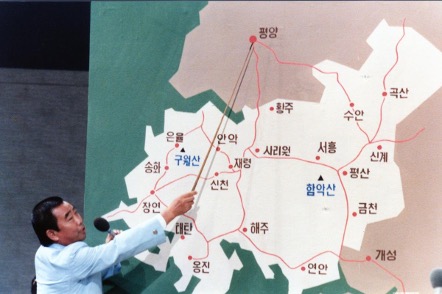
Finding Dispersed Families also brought attention to war orphans and international adoptions, a fraught subject in South Korea. In the film, Mak-soon’s adoption is presented as the inevitable result of war chaos, but adoptions continued well into the postwar period. 200,000 South Korean children were adopted in the fifty years that followed the Korean War, primarily to the United States. Anthropologist Eleana Kim writes that, while the first adoptions were targeted at “racially stigmatized” “mixed race” children born from Korean mothers and foreign servicemen, the practice expanded to include “full-Korean children” (502). Transnational adoption was not a purely humanitarian endeavor, however, because it was linked to money. Unscrupulous adoption agencies trafficked in children to families in wealthy nations that paid adoption fees. While adoption was presented as a solution in the best interest of orphaned children, “adult adoptees are now discovering that they were primarily victims of poverty, family dissolution, or the stigma of legitimacy” and “A grossly under-funded social welfare system, patriarchal family ideologies and misogynist legal codes” (Eleana Kim 503). Like the services of sex workers, laborers, and soldiers, that were sold as commodities to help develop the nation, the export of babies was a convenient way to manage social problems and a way for much needed foreign currency to flow into South Korea. During the height of the Cold War, North Korea was one of the most vociferous critics of the practice, and it was curbed in the 1970s in response to criticism. By the 1980s, however, South Korea was eager to improve relations with the West and “overseas adoption was radically expanded as part of an emigration and civil diplomacy (min’gan oegyo) project” (ibid). Ironically, the effort ended up (again) embarrassing the South Korea state when coverage surrounding the 1988 Olympics drew attention to its “export” of babies (ibid). In other words, Finding Dispersed Families drew attention to transnational adoption just as the practice was entering a new and contentiou phase. Since the 90s, the visibility of returned adoptees has grown, and questions about the practice are regularly aired in South Korea’s mass media.
The explicit historic arc of Ode to My Father essentially ends with this last vignette in the 1980s. While the frame story is set in the present (2014), the film doesn’t present any significant historic events after 1983. The fallout of South Korea’s democracy movement in the late 1980 and the economic trauma of the IMF crisis in 1997, for example, are not mentioned. It’s possible, however, to discern some clues about more recent history. For one, in 2014, the film shows that South Korea had become a destination for migrant workers looking for a good life: a South Asian couple is shown enjoying a day off in Gukje Market. Unlike Duk-soo, who never thought himself German, when they are harassed by racist bullies, the South Asians proudly proclaim that because they live and work in Busan, they too are South Korean. These characters point to the steady increase in immigration to South Korea, especially from other, poorer Asian nations, as the nation’s economy has grown in recent years. The demand for urban redevelopment is a second economic clue in the film’s 2014 frame story. Duk-soo is hounded by agents of a developer who want to transform Gukje Market, presumably to remake it as a fancy shopping center. It is implied that Duk-soo finally caves, knowing that his father is likely dead, and that holding on to the storefront in the hopes of a reunion is meaningless. A marketplace that grew out of South Korea’s imbrication with the global Cold War will be transformed into a new type of “international market,” a shopping mall where South Korean consumers can enjoy their country’s wealth. The film thus excavated the legacy and memory of South Korean development just before the physical traces of this history were “redeveloped” and removed from sight.
Developmental State Timeline
The following timeline provides an orientation in the historical events that appear in the film. Events referenced directly in the film (which appear as text on screen) are set off in bold Italics and contextualized with relevant text from the historical background above. In the film, South Korean “history” begins in 1950, and there is no reference to the period of division that preceded the Korean War or the colonial period that formally spanned from 1910 to 1945. The film guide to A Taxi Driver [hyperlink] provides a more detailed timeline of that history. Japan’s colonization of the Korean peninsula, occasioned by a series of wars between Japan and China and Russia, was part of an expansionist project aimed at building a modern, Asian empire. Colonization included fast economic development (which was designed to benefit the Japanese Empire) and varying degrees of political and cultural suppression. After taking over Korea, Japan pushed further into the Asian continent and established the puppet state of Manchukuo in northern China. In 1937, Japan invaded China, starting the Second-Sino Japanese War, a conflict that would become part of World War II. Korea was crucial as a logistical hub and source of labor and manpower for the empire’s military goals. Japan’s 1945 defeat in WWII left Korea divided between the Soviet and American spheres of interest. In both the North and South, Koreans debated how best to recover from the economic and political fallout of the war and colonial period. The North held relatively free elections that favored leftist parties aligned with the Soviet Union, while the in South, which occupied by the United States, political dissent was suppressed in favor of conservative candidates that appealed to American policymakers. Many prominent conservative figures were problematically associated with Japan: they had collaborated with the colonizers (who were also anti-communists). Syngman Rhee, an authoritarian anti-communist leader backed by the US, emerged as a viable option because he had fled Korea after a failed protest in 1919, and was thus unblemished by collaboration. He became the first president of South Korea in 1948. His radio address announcing the armistice that ended hostilities in the Korean War is featured in Ode to My Father.
Link to Developmental State Timeline
This film guide was developed by Julia Keblinska, The Ohio State University and is available online for classroom use worldwide. The film guides can be accessed at EASC's Film Guide page.
